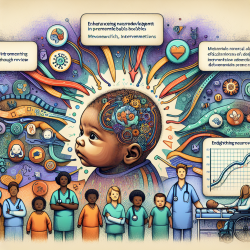Introduction
In the quest to understand autism, researchers have increasingly turned their attention to synaptopathies—disorders of synaptic function that may hold the key to unlocking the complexities of autism. The recent study, "Bridging the translational gap: what can synaptopathies tell us about autism?" offers compelling insights into the molecular pathways involved in autism, particularly focusing on the NRXN-NLGN-SHANK pathway. This pathway is crucial for synaptic assembly and functioning, and disruptions here could lead to the features observed in autism.
Understanding Synaptopathies
Synaptopathies are characterized by genetic variants that disrupt synaptic biology, often leading to developmental delays and neuropsychiatric conditions, including autism. The study highlights the NRXN1 deletion and SHANK3 mutations, which are associated with autism and offer a window into the synaptic disruptions that may underlie the condition.
Key Findings and Implications
The study underscores the importance of understanding the NRXN-NLGN-SHANK pathway, which plays a significant role in maintaining the balance between excitatory and inhibitory neurotransmission—a balance that is often disrupted in autism. By studying induced pluripotent stem cells (iPSCs) and animal models, researchers have identified potential biomarkers and therapeutic targets.
- NRXN1 deletions are linked to altered neurogenesis and synaptic function, which could explain some autism-related behaviors.
- SHANK3 mutations lead to impaired synaptic transmission and are associated with autism-like behaviors in animal models.
Bridging the Translational Gap
One of the significant challenges in autism research is translating findings from preclinical models to human applications. The study emphasizes the need for alignment between preclinical and clinical methodologies to develop targeted therapies. This alignment could pave the way for personalized treatment approaches, improving outcomes for individuals with autism.
Practical Applications for Practitioners
For practitioners, these findings highlight the potential for developing therapies that target specific synaptic disruptions. By focusing on the molecular underpinnings of autism, speech-language pathologists and other clinicians can better tailor their interventions to the unique needs of each child, potentially enhancing the effectiveness of therapy.
Encouraging Further Research
While this study provides valuable insights, it also opens the door for further research. Understanding the full impact of synaptopathies on brain development and behavior will require continued investigation, particularly in translating these findings into clinical practice.
Conclusion
Synaptopathies offer a promising avenue for understanding and treating autism. By bridging the gap between molecular research and clinical application, we can move closer to personalized therapies that improve the lives of those with autism. For those interested in delving deeper into the research, the original study provides a comprehensive overview of the current state of knowledge and future directions.
To read the original research paper, please follow this link: Bridging the translational gap: what can synaptopathies tell us about autism?










